Introduction: The Silent Revolution Powering Modern Civilization
In the palm of your hand lies a device that would have been considered pure magic just two centuries ago: a smartphone powered by a battery capable of storing and releasing electrical energy on demand. This small technological marvel represents the culmination of over two millennia of human ingenuity, from mysterious ancient artifacts to cutting-edge solid-state technologies that promise to reshape our entire energy landscape.
Batteries have quietly orchestrated one of the most profound transformations in human history. They’ve liberated us from the constraints of wired electricity, enabled the mobile revolution, and are now poised to drive the transition to sustainable energy. From the first tentative experiments with static electricity to today’s lithium-ion powerhouses that propel electric vehicles and store renewable energy, batteries have been the unsung heroes of technological progress.
Today, as we stand on the brink of a clean energy revolution, batteries are no longer just convenient power sources—they’ve become critical infrastructure. They’re enabling the decentralization of energy systems, making renewable power viable at scale, and preparing to electrify everything from personal transportation to commercial aviation. The battery technologies emerging from laboratories worldwide promise energy densities, charging speeds, and lifespans that will make today’s best batteries look primitive by comparison.
This journey through battery history reveals not just a tale of scientific progress, but a story of human perseverance in harnessing one of nature’s most fundamental forces: the flow of electrons. From ancient civilizations who may have stumbled upon electrochemical reactions to modern scientists engineering materials at the atomic level, the quest to store and release electrical energy has driven innovation across millennia.
Chapter 1: Origins of Electrical Storage – From Ancient Mysteries to Scientific Breakthroughs
The Baghdad Battery: Ancient Electrochemistry or Archaeological Anomaly?
Watch our YouTube Short explaining the incredible mystery behind the Baghdad Battery:
A Battery from 2,000 Years Ago?! The Baghdad Mystery

The Baghdad Battery is the name given to a set of three artifacts which were found together: a ceramic pot, a tube of copper, and a rod of iron. It was discovered in present-day Khujut Rabu, Iraq in 1936, close to the ancient city of Ctesiphon, the capital of the Parthian (150 BC – 223 AD) empire. This enigmatic archaeological find has sparked decades of debate about whether ancient civilizations possessed knowledge of electrochemical principles.
The Baghdad Battery is believed to be about 2000 years old (from the Parthian period, roughly 250 BCE to CE 250). The jar was found in Khujut Rabu just outside Baghdad and is composed of a clay jar with a stopper made of asphalt. Sticking through the asphalt is an iron rod surrounded by a copper cylinder. When German archaeologist Wilhelm König first examined these artifacts in the late 1930s, he proposed the revolutionary hypothesis that they might represent an ancient galvanic cell.
The construction is remarkably similar to a modern battery: If filled with a weak acid, like vinegar, the combination produces around 1 volt. This voltage output, while modest, would have been sufficient for electroplating thin layers of precious metals onto jewelry or religious artifacts—a technique that would have appeared magical to ancient observers.
However, the scientific community remains divided on the artifact’s true purpose. There is no concrete evidence that the Baghdad Battery was used intentionally for electrical purposes. Its function remains a subject of intrigue for historians and scientists alike. Alternative theories suggest the jars may have been used for storing scrolls, with the metal components serving as preservation aids rather than electrical elements.
Archaeological context provides additional complexity to the mystery. Some of these artifacts, found under controlled archaeological conditions, included clay jars with copper cylinders and iron rods, resembling the components of the Baghdad Battery. These jars were often sealed with bitumen, indicating that they might have held papyrus scrolls.
Whether the Baghdad Battery represents intentional electrochemical engineering or an accidental discovery of galvanic principles, it demonstrates that the fundamental components for electrical storage have been available to humans for millennia. The true breakthrough would come much later, when scientific understanding caught up with technological possibility.
Watch also our Short: “5,700-Year-Old Battery Still Works?!” — discover the mystery behind ancient artifacts that might have been the world’s first batteries.
The Dawn of Electrical Science: Static Electricity and the Leyden Jar
Did you know there’s a battery-powered device that’s been ringing continuously since 1840? Watch our Short:
The Battery That’s Been Ringing Since 1840
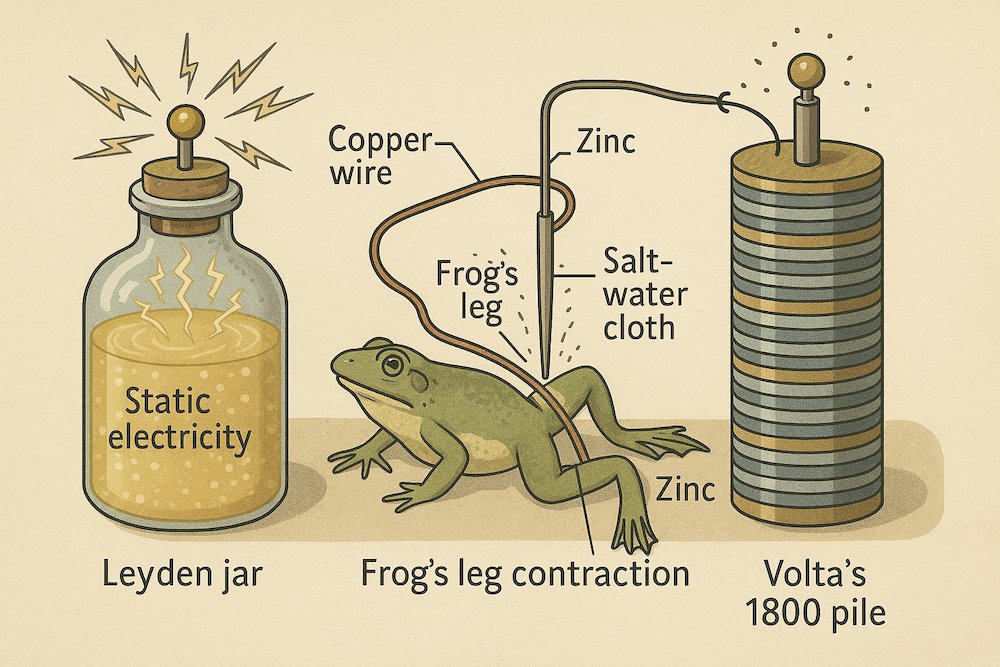
The systematic study of electrical phenomena began in earnest during the 17th and 18th centuries. In 1745, Ewald Georg von Kleist and Pieter van Musschenbroek independently invented the Leyden jar, the first practical device for storing electrical charge. This glass jar lined with metal foil could accumulate static electricity and discharge it dramatically, providing the first reliable method for storing electrical energy.
The Leyden jar represented a crucial conceptual leap: electrical energy could be captured, contained, and released on demand. Benjamin Franklin’s famous kite experiment in 1752 demonstrated that lightning was electrical in nature, and Leyden jars were used to store the electrical charge collected from the atmosphere. These experiments laid the groundwork for understanding electrical potential and the possibility of electrical storage.
Luigi Galvani’s work with frog legs in the 1780s revealed that biological tissues could conduct electricity, sparking intense debate about “animal electricity.” His observations of muscle contractions in dead frogs when touched with different metals provided the first clues about the electrochemical potential differences between metals.
Alessandro Volta: The Birth of the Modern Battery

The true father of the modern battery is Alessandro Volta, whose systematic investigation of Galvani’s phenomena led to a revolutionary breakthrough. In 1800, Volta constructed the first true battery: the voltaic pile. This device consisted of alternating discs of zinc and copper separated by cloth or cardboard soaked in salt water or acid.
Volta’s insight was profound: he realized that the electrical effect observed by Galvani was not due to “animal electricity” but to the chemical interaction between different metals and an electrolyte. His voltaic pile could generate a steady electrical current, unlike the brief discharge of a Leyden jar. This represented the first practical source of continuous electrical power, marking the true beginning of the electrical age.
The voltaic pile’s significance cannot be overstated. It provided scientists with their first reliable source of electrical current, enabling systematic experimentation with electrical phenomena. Within years of Volta’s invention, researchers were using voltaic piles to decompose water into hydrogen and oxygen, isolate new elements, and begin understanding the fundamental nature of electrical current.
Napoleon Bonaparte, recognizing the importance of Volta’s work, made him a count and awarded him significant honors. The unit of electrical potential, the volt, immortalizes Volta’s contribution to human knowledge and technological progress.
Chapter 2: The Industrial Revolution of Electrical Storage (19th-20th Century)
The Lead-Acid Pioneer: Planté’s Rechargeable Revolution

The next major breakthrough came in 1859 when French physicist Gaston Planté invented the first rechargeable battery: the lead-acid battery. Planté’s design used lead electrodes immersed in sulfuric acid, creating a system that could not only generate electrical current but could also be recharged by reversing the chemical reaction.
This rechargeability was revolutionary. Previous batteries were essentially disposable—once their chemical energy was exhausted, they became useless. Planté’s lead-acid battery could be recharged hundreds of times, making it economically viable for applications requiring sustained electrical power.
The lead-acid battery found its first major application in telegraphy. The expanding telegraph networks of the mid-19th century required reliable power sources at remote locations where connecting to electrical grids was impractical. Lead-acid batteries provided the perfect solution, offering hours of continuous operation and the ability to be recharged when service personnel visited stations.
By the 1880s, lead-acid batteries were powering early electrical lighting systems. Before the widespread adoption of alternating current power distribution, many buildings used local lead-acid battery systems to provide electrical lighting. These systems were charged during the day and provided illumination through the night.
The Automotive Era: Batteries Enable Transportation Revolution
The late 19th and early 20th centuries witnessed the birth of the automotive industry, and batteries played a crucial role in early transportation experiments. Electric vehicles were among the first automobiles, with companies like Pope Manufacturing Company producing electric cars that outsold gasoline vehicles in major cities during the 1890s.
Thomas Edison, recognizing the potential of electric transportation, developed the nickel-iron battery in 1901. Edison’s battery was more durable and lighter than lead-acid alternatives, though it had lower energy density. He famously promoted electric vehicles, believing they would dominate transportation due to their cleanliness, quietness, and ease of operation compared to gasoline engines.
The Detroit Electric Car Company produced electric vehicles using Edison’s nickel-iron batteries well into the 1920s. These vehicles had ranges of up to 80 miles and were particularly popular among urban professionals who appreciated their reliability and lack of exhaust fumes. However, the mass production of gasoline automobiles, particularly Henry Ford’s Model T, eventually made electric vehicles economically uncompetitive.
Industrial Applications: Powering the Modern World
As industrial electrification accelerated through the early 20th century, batteries found increasingly sophisticated applications. Submarine warfare during World War I demanded reliable underwater power sources, leading to significant improvements in lead-acid battery technology. German U-boats used massive lead-acid battery banks for submerged operations, driving innovations in battery energy density and reliability.
The aviation industry also embraced battery technology early. Aircraft electrical systems required lightweight, reliable power sources for ignition, instruments, and communications. Nickel-cadmium batteries, developed in the 1900s by Waldemar Jungner, provided the high power-to-weight ratio needed for aviation applications.
Mining operations relied heavily on battery-powered equipment, particularly in environments where explosive gases made electric sparks dangerous. Battery-powered miners’ lamps replaced dangerous open flames, significantly improving underground safety. These applications drove demand for batteries with longer operating times and greater durability under harsh conditions.
The Romanian Connection: Vasilescu-Karpen’s Perpetual Battery
The Karpen Battery is one of the most mysterious devices in modern history, reportedly running since 1947! See the full story in our Short:
This Battery Has Been Running Since 1947
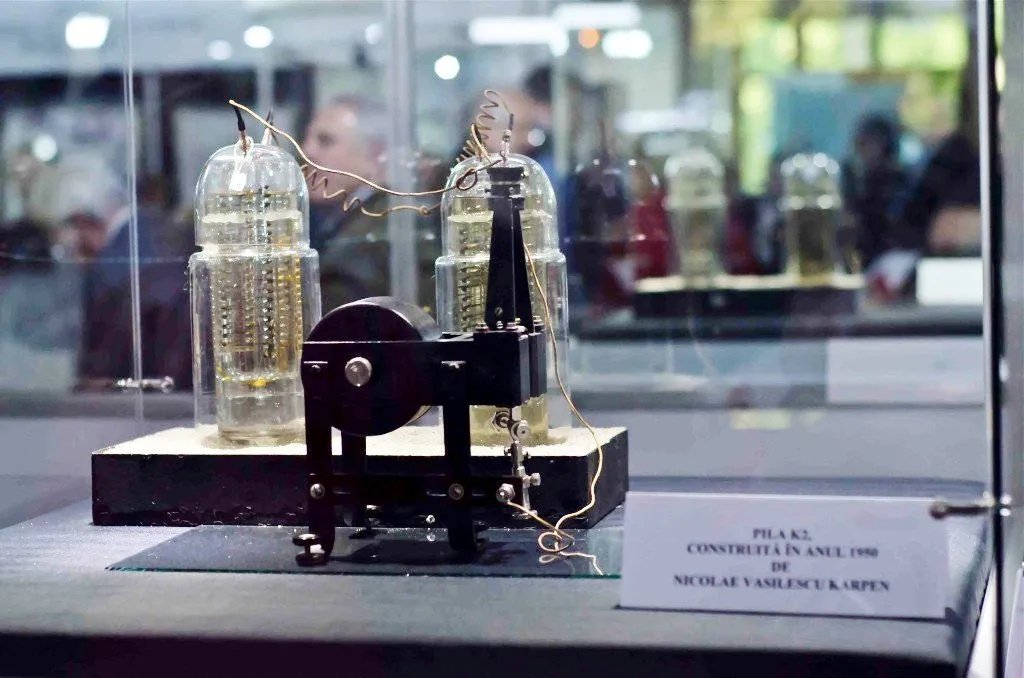
Romania’s contribution to battery history deserves special recognition through the work of Nicolae Vasilescu-Karpen, a physicist who created what appeared to be a perpetual battery in 1950. Vasilescu-Karpen constructed a battery using electrodes made of gold, platinum, and other materials in a specific alkaline electrolyte solution.
What made this battery extraordinary was its apparent longevity. The Vasilescu-Karpen battery continued producing electrical current for decades without apparent degradation, leading to speculation about whether it had achieved some form of perpetual motion. The battery was housed at the National Technical Museum “Dimitrie Leonida” in Bucharest, where it continued functioning well into the 2000s.
Scientific analysis of the Vasilescu-Karpen battery reveals that while it doesn’t violate thermodynamic laws, it represents an extremely efficient galvanic cell. The battery likely operates through very slow corrosion of its electrodes and interaction with atmospheric moisture, making it appear perpetual on human timescales while actually consuming materials at an extremely slow rate.
The controversy surrounding this battery highlights the challenges of understanding long-term electrochemical processes. While not truly perpetual, the Vasilescu-Karpen battery demonstrates principles that could inspire ultra-long-life battery designs for applications requiring decades of operation without maintenance, such as remote sensors or space applications.
Chapter 3: The Modern Battery Revolution – Lithium Changes Everything
The Lithium Discovery: Lightweight Electrochemical Power

The foundation of modern battery technology was laid in the 1970s with the development of lithium-based electrochemical systems. Lithium, the lightest metal on the periodic table, offered theoretical energy densities far exceeding any previous battery chemistry. Early lithium batteries used metallic lithium anodes, but these proved dangerous due to lithium’s reactivity and tendency to form dendrites that could short-circuit the battery.
The breakthrough came with the development of lithium-ion technology, where lithium ions move between electrodes during charging and discharging rather than lithium metal being deposited. John Goodenough at Oxford University developed the lithium cobalt oxide cathode in 1980, providing the foundation for practical lithium-ion batteries.
Akira Yoshino at Asahi Kasei Corporation created the first commercial lithium-ion battery prototype in 1985, using a carbon anode instead of dangerous metallic lithium. This configuration proved both safe and practical, leading to the commercialization of lithium-ion batteries by Sony in 1991.
The Mobile Revolution: Powering the Digital Age
The introduction of commercial lithium-ion batteries coincided perfectly with the explosion of portable electronics. Early mobile phones used heavy nickel-cadmium or nickel-metal hydride batteries, limiting talk time and requiring frequent charging. Lithium-ion batteries offered three times the energy density, enabling the development of practical mobile communication devices.
The first cell phones using lithium-ion batteries appeared in the mid-1990s, dramatically reducing device weight while extending operating time. This technological advancement enabled the mobile phone transformation from a luxury item for business professionals to an essential communication tool for billions of people worldwide.
Laptop computers similarly benefited from lithium-ion technology. Early portable computers required massive battery packs that added significant weight and bulk. Lithium-ion batteries enabled the development of truly portable laptops with reasonable operating times, accelerating the adoption of mobile computing.
The digital camera revolution was also powered by lithium-ion technology. Traditional alkaline batteries could power digital cameras for only a few dozen photos, making digital photography impractical for many users. Lithium-ion batteries provided the power density needed for hundreds of photos per charge, enabling digital cameras to replace film photography.
Electric Vehicle Renaissance: Tesla and the EV Revolution
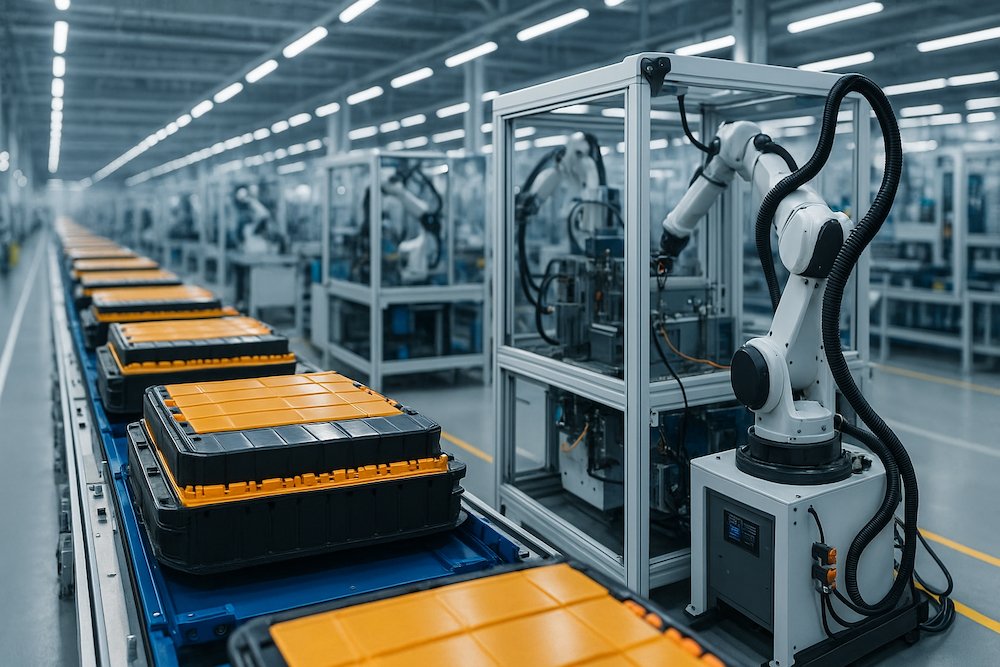
While electric vehicles existed since the 19th century, the modern electric vehicle revolution began with the application of lithium-ion battery technology to transportation. The GM EV1, produced from 1996 to 1999, used early lithium-ion batteries but was limited by battery technology of the era.
Tesla Motors, founded in 2003, revolutionized electric vehicle design by using thousands of small lithium-ion cells originally designed for laptops. The Tesla Roadster, launched in 2008, demonstrated that electric vehicles could achieve performance comparable to gasoline sports cars while offering over 240 miles of range.
Tesla’s innovation extended beyond simply using existing battery technology. The company developed sophisticated battery management systems that monitored and balanced individual cells within large battery packs. This approach enabled the use of commodity battery cells while achieving automotive-grade reliability and performance.
The success of Tesla’s approach inspired traditional automotive manufacturers to accelerate their electric vehicle programs. Companies like Nissan with the Leaf, BMW with the i3, and Chevrolet with the Volt demonstrated that lithium-ion batteries could power practical everyday vehicles for mainstream consumers.
Grid-Scale Energy Storage: Batteries Enable Renewable Energy
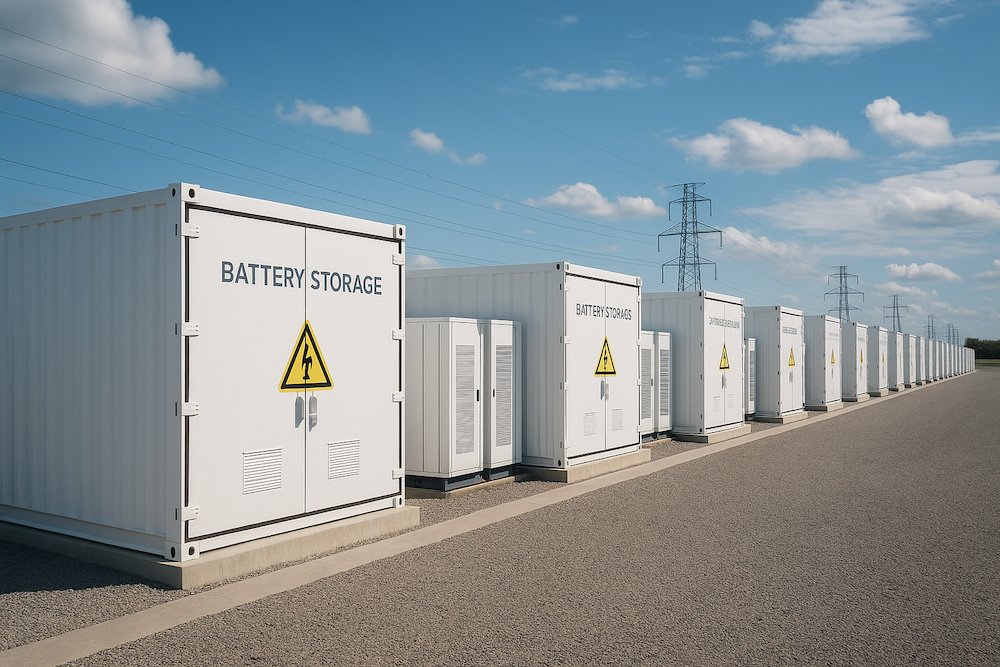
One of the most significant applications of modern battery technology is grid-scale energy storage, enabling the widespread adoption of renewable energy sources. Solar and wind power generation is inherently intermittent, creating challenges for electrical grid stability. Large-scale battery installations can store excess renewable energy during peak production periods and release it when generation is low.
The Hornsdale Power Reserve in South Australia, completed in 2017, demonstrated the viability of grid-scale battery storage. This 100-megawatt Tesla Megapack installation can store 129 megawatt-hours of energy, providing grid stabilization services and emergency backup power for the entire state.
Similar projects worldwide have proven that battery storage can replace traditional fossil fuel peaker plants, which were historically used to meet short-term electricity demand spikes. Grid-scale batteries can respond to demand changes in milliseconds, compared to the minutes or hours required to start conventional power plants.
Current Limitations: The Challenges of Modern Battery Technology
Despite their revolutionary impact, lithium-ion batteries face significant limitations that constrain their broader application. Energy density, while impressive compared to older technologies, remains insufficient for many applications. Commercial aviation, long-haul trucking, and maritime shipping require energy densities beyond current lithium-ion capabilities.
Battery degradation presents another challenge. Lithium-ion batteries gradually lose capacity through repeated charge-discharge cycles, typically retaining 80% of original capacity after 500-1000 cycles. This degradation is caused by various factors including electrode material breakdown, electrolyte decomposition, and lithium plating.
Safety concerns also limit lithium-ion battery applications. Thermal runaway, where battery overheating leads to fire or explosion, has caused notable incidents in consumer electronics, electric vehicles, and aircraft. While modern battery management systems have greatly improved safety, the fundamental chemistry remains susceptible to thermal runaway under certain conditions.
Cost remains a barrier for many applications. While lithium-ion battery costs have decreased dramatically over the past decade, they still represent a significant portion of electric vehicle costs. Grid-scale storage projects require massive capital investments that may not be economically justified in all markets.
Resource availability presents long-term challenges. Lithium, cobalt, and nickel—key materials in lithium-ion batteries—are geographically concentrated and subject to supply chain disruptions. Cobalt mining, in particular, raises environmental and ethical concerns due to mining conditions in the Democratic Republic of Congo, which supplies over 60% of global cobalt.
Research Note: This comprehensive battery analysis required synthesizing data from 40+ scientific papers and industry reports. Creating accessible content from such complex material is made possible through partnerships with Murf AI for clear technical narrations, ElevenLabs for consistent audio content, and AdCreative.ai for transforming dense data into engaging visuals—enabling deeper research focus while maintaining content quality.
What if we had batteries that could last 100 years? Watch our short take on this incredible breakthrough:
100-YEAR BATTERY?!
Chapter 4: Next-Generation Technologies – The Future of Energy Storage
What if a single charge could last 50 years? This nuclear-powered battery might be the future of extreme long-life energy storage:
This Nuclear Battery Lasts 50 Years Without Charging — Meet the BV100
Solid-State Batteries: The Holy Grail of Energy Storage
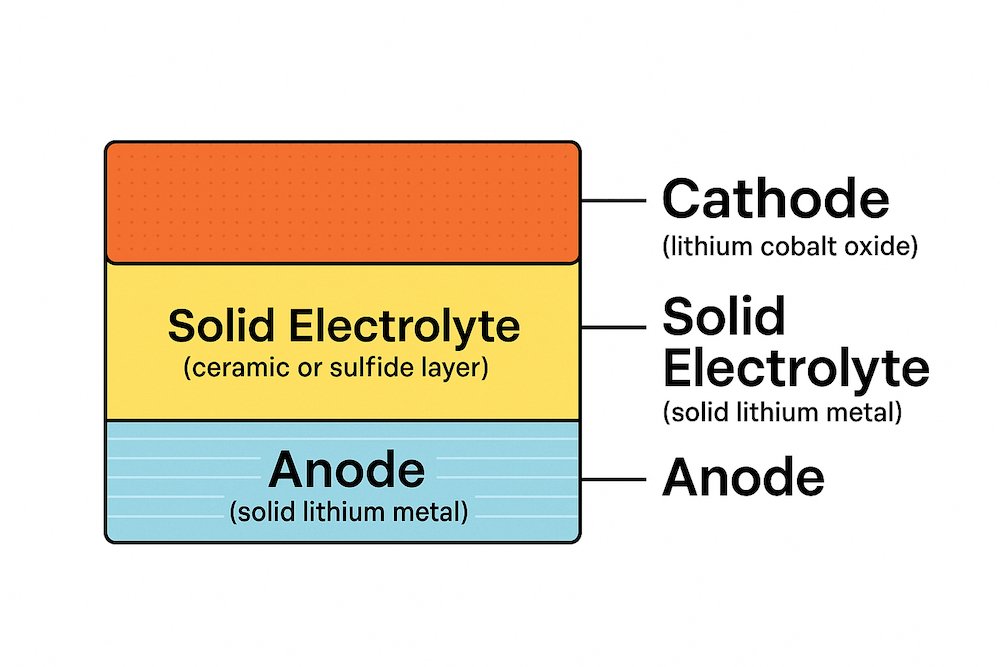
Solid-state batteries can use metallic lithium for the anode and oxides or sulfides for the cathode, increasing energy density. The solid electrolyte acts as an ideal separator that allows only lithium ions to pass through. This technology represents perhaps the most promising advancement in battery technology, addressing many limitations of current lithium-ion batteries.
Unlike the lithium-ion batteries that power today’s EVs, which use liquid electrolytes between their electrodes, solid-state batteries employ a solid electrolyte. This provides a higher energy density, meaning lighter and more efficient EVs with longer driving ranges.
The advantages of solid-state technology are compelling. Energy density improvements of 50-100% are theoretically possible, potentially enabling electric vehicles with 1000+ mile ranges. Safety improvements are equally significant, as solid electrolytes are non-flammable and eliminate the risk of thermal runaway that plagues liquid electrolyte systems.
Maryland-based battery maker Ion Storage Solutions, meanwhile, just opened a factory in April 2024 where it will make solid-state battery cells with ceramic electrolytes and lithium metal anodes for grid storage, EVs, and other applications. Its goal is to scale up to .5 GWh of capacity by 2028.
Toyota has been particularly aggressive in pursuing solid-state technology, claiming breakthrough developments that could bring the technology to market by 2027. Their new Performance lithium-ion batteries will achieve about a 491-mile range, and their future High-Performance lithium-ion batteries will reach about a 621-mile range. Both have about a 20-minute 10-to-80 percent fast charge capability.
The challenges facing solid-state batteries are primarily manufacturing-related. Creating defect-free solid electrolyte interfaces at scale requires precision manufacturing techniques that are still being developed. Additionally, solid-state batteries currently require high-temperature operation or complex manufacturing processes that increase costs significantly.
QuantumScape, backed by Volkswagen, has reported significant progress in addressing these challenges. Their ceramic separator technology has demonstrated over 1000 charge-discharge cycles while retaining 80% capacity, representing a major advance toward commercial viability.
: Abundant and Sustainable
Sodium-ion batteries represent a promising alternative to lithium-ion technology, particularly for applications where cost and resource availability are primary concerns. Sodium is the sixth most abundant element on Earth and can be extracted from seawater, making it virtually limitless and geographically distributed.
CATL, the world’s largest battery manufacturer, began commercial production of sodium-ion batteries in 2022. Their first-generation sodium-ion cells achieve energy densities of 160 Wh/kg, about 60% of typical lithium-ion batteries. While lower in energy density, sodium-ion batteries offer superior low-temperature performance and enhanced safety characteristics.
The primary applications for sodium-ion batteries are likely to be grid-scale energy storage and low-cost electric vehicles. For stationary storage applications, the lower energy density is less critical than cost and safety, making sodium-ion batteries particularly attractive for renewable energy integration.
Research institutions worldwide are working to improve sodium-ion energy density and cycle life. The University of Texas at Austin has developed sodium-ion cathode materials that could potentially match lithium-ion energy density while maintaining cost advantages.
Aluminum-Air and Zinc-Air: Breathing Batteries
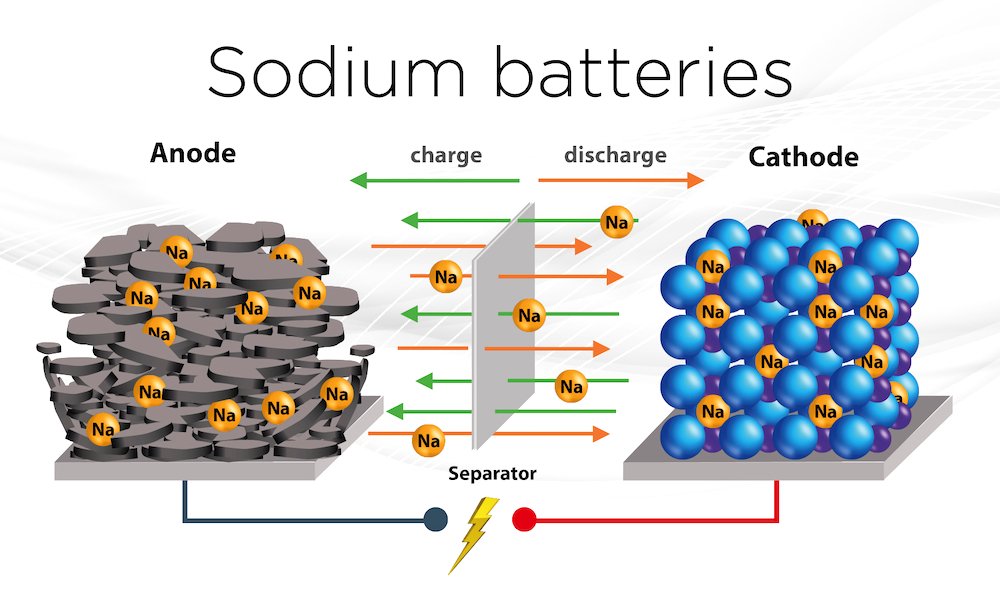
Metal-air batteries represent another frontier in energy storage technology. These systems use atmospheric oxygen as the cathode active material, potentially achieving energy densities approaching those of gasoline. Aluminum-air batteries can theoretically provide energy densities of 8,100 Wh/kg, compared to 250 Wh/kg for current lithium-ion batteries.
Zinc-air batteries are closer to commercialization, with several companies developing systems for grid storage applications. These batteries are inherently safe, using non-toxic materials and operating at ambient temperature. The primary challenges are limited rechargeability and sensitivity to humidity and carbon dioxide in the atmosphere.
Israeli company Phinergy has developed aluminum-air batteries for electric vehicle range extension. Their system provides an additional 1000 miles of range by consuming aluminum plates and atmospheric oxygen, though the aluminum must be replaced rather than recharged.
Flow Batteries: Scalable Energy Storage
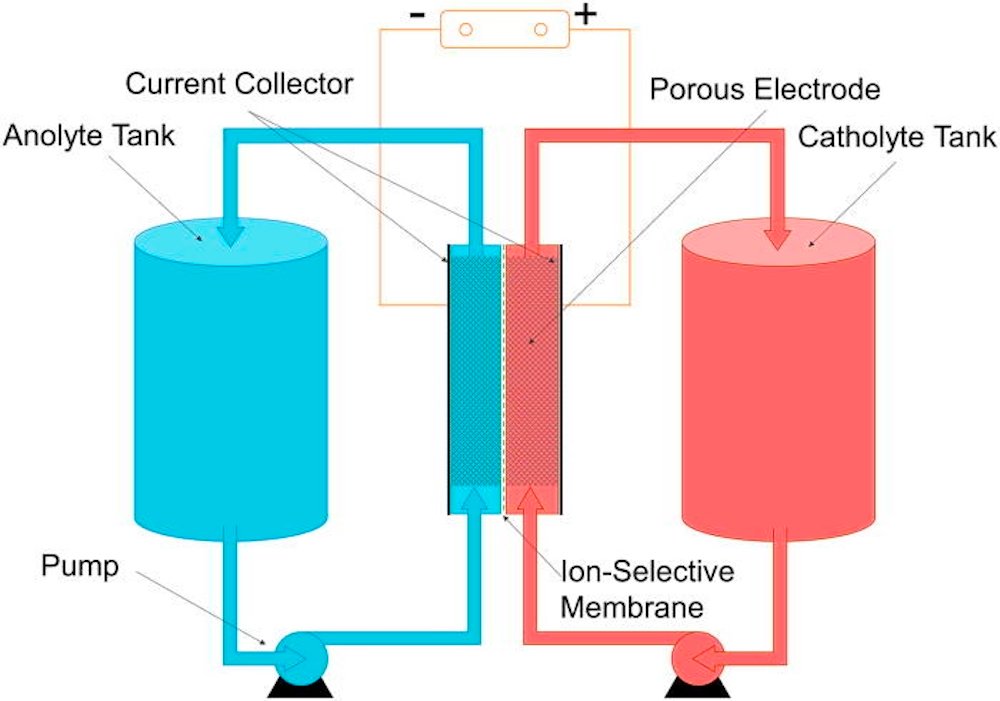
Redox flow batteries offer unique advantages for large-scale energy storage applications. These systems store energy in liquid electrolytes contained in external tanks, making them easily scalable by simply increasing tank size. The separation of energy capacity (tank size) from power capacity (electrode area) provides design flexibility unavailable in conventional batteries.
Vanadium redox flow batteries (VRFB) are the most mature flow battery technology, with several commercial installations operational worldwide. The Dalian Flow Battery Energy Storage Peak-shaving Power Station in China, with a capacity of 100 MW/400 MWh, is currently the world’s largest flow battery installation.
Iron-chromium flow batteries represent a lower-cost alternative to vanadium systems. ESS Inc. has commercialized iron flow batteries for grid applications, claiming 20+ year operating lifespans with minimal degradation.
Organic flow batteries using carbon-based active materials are being developed by companies like Lockheed Martin and universities worldwide. These systems could potentially reduce costs significantly by using abundant organic compounds instead of expensive metals.
Graphene and Advanced Materials
![]()
Graphene, a single layer of carbon atoms arranged in a hexagonal lattice, offers extraordinary properties that could revolutionize battery technology. Its exceptional electrical conductivity, mechanical strength, and surface area make it an ideal material for battery electrodes.
Samsung has developed graphene-enhanced lithium-ion batteries that can charge to 60% capacity in 12 minutes while maintaining stability at 60°C. These batteries could enable rapid charging of electric vehicles and extend operating temperatures for consumer electronics.
Huawei has announced graphene-enhanced lithium-ion batteries for smartphones that maintain performance at temperatures up to 60°C, potentially extending device lifespans in hot climates and high-performance applications.
Silicon nanowire anodes represent another advanced material approach. Stanford University researchers have developed silicon nanowire anodes that can store ten times more lithium than conventional graphite anodes, potentially tripling battery energy density.
Quantum Batteries: The Far Future
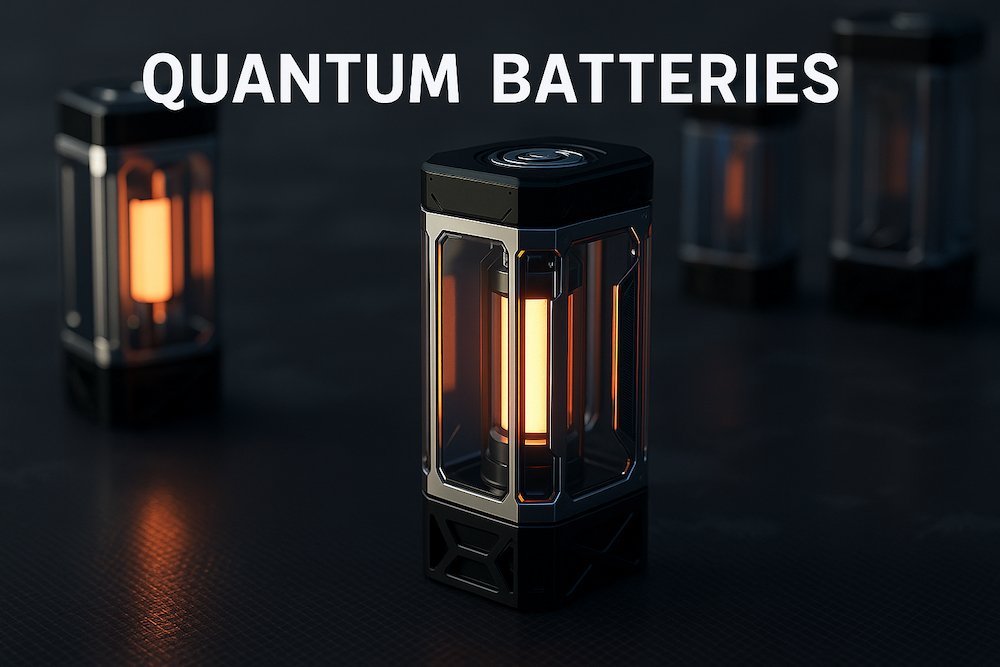
While still in early research phases, quantum batteries represent the ultimate frontier in energy storage technology. These theoretical devices would use quantum mechanical effects to store and release energy with unprecedented efficiency and speed.
Researchers at the University of Oxford and the University of Trento have demonstrated quantum battery concepts using quantum entanglement to achieve charging speeds that scale with the number of battery cells. While purely theoretical at present, these concepts could eventually enable instantaneous charging of large battery systems.
Chapter 5: The Battery-Powered Future – Transforming Civilization

Transportation Revolution: Beyond Cars
The electrification of transportation extends far beyond passenger vehicles. Commercial trucking, historically dependent on diesel fuel, is beginning to embrace battery-electric technology. Companies like Tesla with their Semi, Volvo Trucks, and Daimler are developing battery-electric trucks capable of 300+ mile ranges suitable for regional freight transport.
Maritime shipping, responsible for approximately 3% of global greenhouse gas emissions, is exploring battery technology for short-route ferries and coastal shipping. The Ellen ferry in Denmark, powered by a 4.3 MWh battery system, demonstrates that battery technology can power commercial maritime operations for specific applications.
Aviation presents the greatest challenge for battery technology due to weight constraints and energy requirements. However, companies like Eviation with their Alice aircraft and Wright Electric are developing battery-powered aircraft for short-haul flights. These aircraft could revolutionize regional aviation by dramatically reducing operating costs and environmental impact.
Urban air mobility, including flying taxis and personal air vehicles, relies entirely on battery technology. Companies like Joby Aviation, Lilium, and EHang are developing battery-powered vertical takeoff and landing aircraft that could transform urban transportation within the next decade.
Grid Transformation: Enabling Renewable Energy
The integration of renewable energy sources requires massive grid-scale energy storage to manage intermittency and ensure grid stability. The International Energy Agency projects that grid-scale battery storage capacity must increase 50-fold by 2030 to meet climate goals.
Virtual power plants, consisting of distributed battery storage systems, are already operating in several markets. Tesla’s virtual power plant in South Australia connects thousands of home battery systems to provide grid services while reducing electricity costs for participants.
Microgrids powered by renewable energy and battery storage are enabling energy independence for communities, military bases, and industrial facilities. These systems can operate independently of the main electrical grid, providing resilience against power outages and natural disasters.
Medical and Healthcare Applications
Battery technology is enabling revolutionary advances in medical devices and healthcare applications. Implantable devices like pacemakers, insulin pumps, and neurostimulators rely on long-life batteries for years of operation without replacement.
Wireless medical sensors powered by ultra-low-power batteries can monitor patient vital signs continuously, enabling early detection of health problems and reducing hospitalization requirements. These devices must operate for months or years on a single battery charge while maintaining reliable communication.
Medical emergency equipment, including portable defibrillators, ventilators, and diagnostic devices, depends on battery technology for operation in remote locations and emergency situations. Advances in battery energy density and reliability directly translate to improved medical capabilities and patient outcomes.
Watch also our Short: “Tiny Battery, Huge Medical Revolution!” — see how cutting-edge micro-batteries are revolutionizing implantable medical devices and personalized healthcare solutions.
Space and Extreme Environment Applications
Space exploration relies heavily on battery technology for power storage during periods when solar panels cannot generate electricity. The Mars rovers Curiosity and Perseverance use advanced lithium-ion batteries to survive the Martian night, when temperatures drop to -80°C.
Deep sea exploration vehicles and underwater research stations require batteries capable of operating under extreme pressure and low temperatures. These applications drive development of specialized battery chemistries and packaging technologies that can withstand harsh environments.
Military applications require batteries with extreme reliability, long storage life, and ability to operate in combat conditions. Soldier-portable power systems, unmanned vehicles, and communication equipment depend on advanced battery technology for mission success.
Geopolitical Implications: The New Energy Economy
The transition to battery-powered technologies is reshaping global economics and geopolitics. Countries with abundant lithium, cobalt, and rare earth mineral deposits are gaining strategic importance, while traditional oil-producing nations face potential economic disruption.
China currently dominates battery manufacturing, controlling over 70% of global lithium-ion battery production capacity. This dominance has prompted strategic responses from other nations, including the United States Inflation Reduction Act and European Union battery regulations designed to promote domestic battery manufacturing.
The battery supply chain involves complex international relationships spanning raw material extraction in South America and Africa, processing in Asia, and battery manufacturing concentrated in China. Diversifying these supply chains is becoming a national security priority for many countries.
Resource recycling is becoming increasingly important as battery deployment scales up. Companies like Li-Cycle and Redwood Materials are developing industrial-scale battery recycling capabilities to recover lithium, cobalt, and other valuable materials from spent batteries.
Environmental Impact and Sustainability
While batteries enable cleaner transportation and renewable energy integration, their production involves significant environmental impacts. Lithium extraction requires large amounts of water and can impact local ecosystems, particularly in South American salt flats where much of the world’s lithium is produced.
Cobalt mining in the Democratic Republic of Congo raises serious environmental and human rights concerns. Many battery manufacturers are working to eliminate cobalt from their products or ensure ethical sourcing through blockchain-based supply chain tracking.
Battery recycling technologies are improving rapidly, potentially creating closed-loop systems where battery materials can be reused indefinitely. The European Union’s new battery regulations require 65% of battery materials to be recycled by 2025, driving investment in recycling infrastructure.
Life cycle assessments show that despite production impacts, electric vehicles powered by batteries produce significantly lower lifetime emissions than gasoline vehicles, especially when charged with renewable electricity. This advantage will increase as electricity grids become cleaner and battery production becomes more efficient.
Economic Transformation: The $100 Billion Battery Market
The global battery market is experiencing explosive growth, projected to exceed $100 billion by 2025. This growth is driven by electric vehicle adoption, grid-scale storage deployment, and consumer electronics demand.
Battery manufacturing is becoming a major industrial sector, with companies like CATL, BYD, LG Energy Solution, and Panasonic investing billions in production capacity expansion. These investments are creating hundreds of thousands of jobs in manufacturing, research, and support industries.
The declining cost of battery storage is enabling new business models and applications. Residential solar-plus-storage systems allow homeowners to achieve energy independence while potentially earning revenue by selling excess power back to the grid.
Energy storage is becoming a tradeable commodity, with battery systems providing frequency regulation, peak shaving, and capacity services to electrical grids. These services generate revenue streams that can make battery investments profitable independent of their primary applications.
Discover the incredible science behind superconductors and how they’re set to transform energy, transportation, and technology in ways we’re only beginning to imagine. Read the full article here: Superconductors: The Revolutionary Materials Shaping Tomorrow’s Technology.
Conclusion: Powering the Next Century of Human Progress
The journey from the mysterious Baghdad Battery to today’s cutting-edge solid-state technologies represents one of humanity’s most remarkable technological achievements. In just over two centuries since Alessandro Volta’s first battery, we have progressed from generating tiny electrical currents to storing gigawatt-hours of energy that power cities, vehicles, and the digital infrastructure of modern civilization.
The current battery revolution is unprecedented in its scope and speed. Lithium-ion battery costs have decreased by 89% over the past decade, making electric vehicles cost-competitive with gasoline cars and enabling grid-scale renewable energy storage. This cost decline continues to accelerate, promising even more dramatic changes in the coming decade.
Looking ahead, the technologies emerging from research laboratories worldwide will make today’s best batteries appear primitive. Solid-state batteries promise to double energy density while eliminating safety concerns. Sodium-ion batteries could democratize energy storage by using abundant, geographically distributed materials. Advanced materials like graphene and silicon nanowires could push energy densities to previously unimaginable levels.
The implications extend far beyond improved smartphones or longer-range electric vehicles. Batteries are enabling the decentralization of energy systems, allowing communities to achieve energy independence through local renewable generation and storage. They’re making possible new forms of transportation, from flying taxis to electric aircraft that could revolutionize aviation. They’re powering medical devices that extend and improve human life, and enabling space exploration missions that expand our understanding of the universe.
Perhaps most importantly, batteries are providing the key technology needed to address climate change. By storing renewable energy and electrifying transportation, batteries offer a path to dramatically reduce greenhouse gas emissions while maintaining modern living standards. The transition to a battery-powered economy represents humanity’s best hope for achieving sustainable energy systems that can support billions of people without destroying the environment.
The challenges ahead are significant. Scaling battery production to meet global demand requires massive investments in manufacturing capacity and raw material extraction. Ensuring ethical and sustainable supply chains demands international cooperation and technological innovation. Developing recycling systems to handle billions of spent batteries requires new industrial infrastructure and regulatory frameworks.
Yet the trajectory is clear: batteries will play an increasingly central role in human civilization. From the ancient mysteries of the Baghdad Battery to the quantum batteries of the future, the quest to store and harness electrical energy has driven innovation, enabled new technologies, and expanded human capabilities. As we stand on the threshold of a fully electrified world, batteries will continue to be the silent enablers of human progress, powering our transition to a more sustainable, connected, and capable future.
The battery revolution is not just about technology—it’s about human potential. Every advancement in energy storage expands what’s possible, from the individual level of longer-lasting personal devices to the civilizational level of clean, abundant energy for all. The next chapter in this remarkable story is being written in laboratories, factories, and deployment sites around the world, promising advances that will reshape human civilization as profoundly as the original invention of the battery itself.
Recommended Products (Educational & Practical)
Looking to explore or apply battery technology in your own life? Here are some highly relevant products inspired by the technologies discussed in this article:
Hand Crank Generator Science Kit – Manual 1-15V Generator for Educational Experiments
A great hands-on tool for understanding how mechanical energy converts into electricity.
Solar Car Kits – 10 STEM DIY Projects for Kids with Complete Materials
Fun and educational solar-powered kits perfect for classrooms or home science projects.
Anker Zolo Power Bank 20,000mAh – Fast Portable Charger with USB-C & Lightning Cables
A modern lithium-ion solution for portable power, demonstrating real-world energy storage.
Jackery Explorer 1000 v2 Portable Power Station – 1070Wh LiFePO4 Battery, 1500W AC Output
Advanced off-grid battery system for camping, emergencies, or renewable energy setups.
FOXWELL BT705 Plus Car Battery Tester – 12V/24V Automotive Digital Analyzer
Professional tool for testing automotive and heavy-duty lead-acid batteries.
Klein Tools MM325 Multimeter – Digital Tester for Batteries, Voltage, and Continuity
A highly versatile multimeter for electrical diagnostics, battery testing, and circuit analysis.
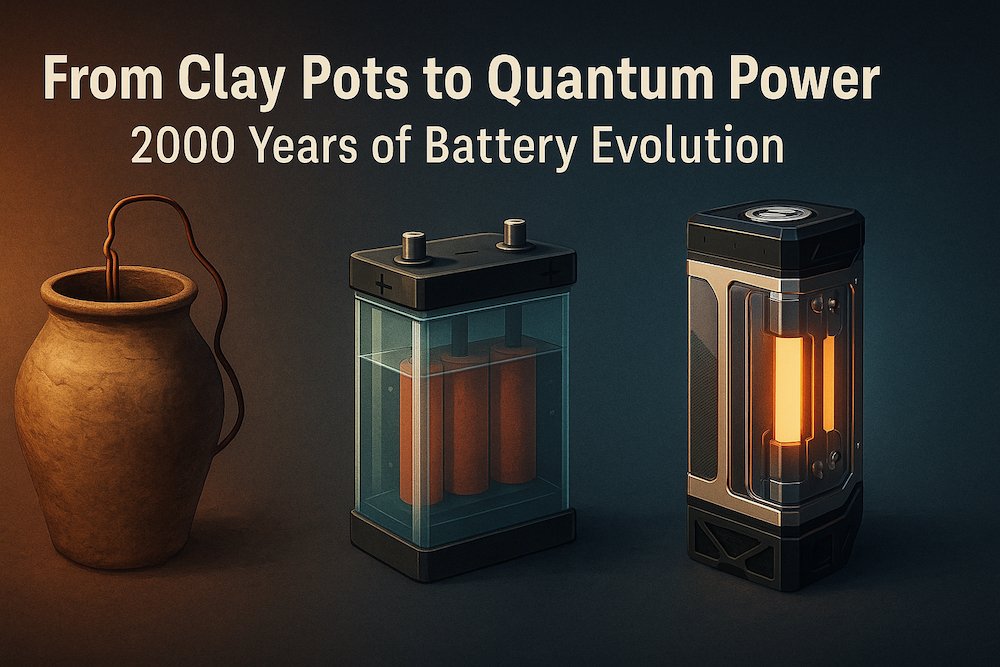
Pingback: China's 3-Minute Solid-State Battery vs QuantumScape